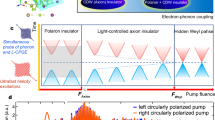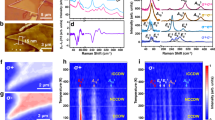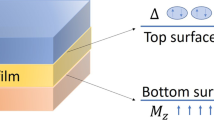Abstract
Chiral superconductors are a class of unconventional superconductors that host topologically protected chiral Majorana fermions at interfaces and domain walls1,2,3, quasiparticles4,5,6 that could serve as a platform for topological quantum computing7. Here we show that, in analogy to a qubit, the out-of-equilibrium superconducting state in such materials can be described by a Bloch vector and predict that they can be controlled on ultrafast timescales. The all-optical control mechanism is universal, permitting arbitrary rotations of the order parameter, and can induce a dynamical change of handedness of the condensate. It relies on transient breaking of crystal symmetries via choice of pulse polarization to enable arbitrary rotations of the Bloch vector. The mechanism extends to ultrafast timescales and the engineered state persists after the pump is switched off. We predict that these phenomena should appear in graphene8,9,10 or magic-angle twisted bilayer graphene11,12,13,14, as well as Sr2RuO4 (refs. 15,16). Furthermore, we show that chiral superconductivity can be detected in time-resolved pump–probe measurements. This paves the way towards a robust mechanism for ultrafast control and measurement of chirally ordered phases and Majorana modes.
This is a preview of subscription content, access via your institution
Access options
Access Nature and 54 other Nature Portfolio journals
Get Nature+, our best-value online-access subscription
$29.99 / 30 days
cancel any time
Subscribe to this journal
Receive 12 print issues and online access
$209.00 per year
only $17.42 per issue
Buy this article
- Purchase on Springer Link
- Instant access to full article PDF
Prices may be subject to local taxes which are calculated during checkout




Similar content being viewed by others
Data availability
All data generated and analysed during this study are available from the corresponding author upon request.
References
Read, N. & Green, D. Paired states of fermions in two dimensions with breaking of parity and time-reversal symmetries and the fractional quantum Hall effect. Phys. Rev. B 61, 10267–10297 (2000).
Schnyder, A. P., Ryu, S., Furusaki, A. & Ludwig, A. W. W. Classification of topological insulators and superconductors in three spatial dimensions. Phys. Rev. B 78, 195125 (2008).
Kallin, C. & Berlinsky, J. Chiral superconductors. Rep. Prog. Phys. 79, 054502 (2016).
Elliott, S. R. & Franz, M. Colloquium: Majorana fermions in nuclear, particle, and solid-state physics. Rev. Mod. Phys. 87, 137–163 (2015).
Beenakker, C. W. J. Search for Majorana fermions in superconductors. Annu. Rev. Condens. Matter Phys. 4, 113–136 (2013).
Alicea, J. New directions in the pursuit of Majorana fermions in solid state systems. Rep. Prog. Phys. 75, 076501 (2012).
Nayak, C., Simon, S. H., Stern, A., Freedman, M. & Sarma, S. D. Non-Abelian anyons and topological quantum computation. Rev. Mod. Phys. 80, 1083–1159 (2007).
Black-Schaffer, A. M. & Doniach, S. Resonating valence bonds and mean-field d-wave superconductivity in graphite. Phys. Rev. B 75, 134512 (2006).
Nandkishore, R., Levitov, L. & Chubukov, A. Chiral superconductivity from repulsive interactions in doped graphene. Nat. Phys. 8, 158–163 (2011).
Kiesel, M., Platt, C., Hanke, W., Abanin, D. A. & Thomale, R. Competing many-body instabilities and unconventional superconductivity in graphene. Phys. Rev. B 86, 020507 (2011).
Cao, Y. et al. Unconventional superconductivity in magic-angle graphene superlattices. Nature 556, 43–50 (2018).
Bistritzer, R. & MacDonald, A. H. Moiré bands in twisted double-layer graphene. Proc. Natl Acad. Sci. USA 108, 12233–12237 (2011).
Liu, C. C., Zhang, L. D., Chen, W. Q. & Yang, F. Chiral spin density wave and d + id superconductivity in the magic-angle twisted bilayer-graphene.Phys. Rev. Lett. 121, 217001 (2018).
Kennes, D. M., Lischner, J. & Karrasch, C. Strong correlations and d + id superconductivity in twisted bilayer graphene. Phys. Rev. B 98, 241407 (2018).
Luke, G. M. et al. Time-reversal symmetry-breaking superconductivity in Sr2RuO4. Nature 394, 558–561 (1998).
Mackenzie, A. P. & Maeno, Y. The superconductivity of Sr2RuO4 and the physics of spin-triplet pairing. Rev. Mod. Phys. 75, 657–712 (2003).
Luke, G. M. et al. Muon spin relaxation in UPt3. Phys. Rev. Lett. 71, 1466–1469 (1993).
Joynt, R. & Taillefer, L. The superconducting phases of UPt3. Rev. Mod. Phys. 74, 235–294 (2002).
Mitrano, M. et al. Possible light-induced superconductivity in K3C60 at high temperature. Nature 530, 461–464 (2016).
Sentef, M. A., Tokuno, A., Georges, A. & Kollath, C. Theory of laser-controlled competing superconducting and charge orders. Phys. Rev. Lett. 118, 087002 (2016).
Sigrist, M. & Ueda, K. Phenomenological theory of unconventional superconductivity. Rev. Mod. Phys. 63, 239–311 (1991).
Hicks, C. W. et al. Strong increase of T c of Sr2RuO4 under both tensile and compressive strain. Science 344, 283–285 (2014).
Sigrist, M. Ehrenfest relations for ultrasound absorption in Sr2RuO4. Prog. Theor. Phys. 107, 917–925 (2002).
Dehghani, H. & Mitra, A. Dynamical generation of superconducting order of different symmetries in hexagonal lattices. Phys. Rev. B 96, 195110 (2017).
Agterberg, D. F. Vortex lattice structure of Sr2RuO4. Phys. Rev. Lett. 80, 5184–5187 (1998).
Scaffidi, T., Romers, J. C. & Simon, S. H. Pairing symmetry and dominant band in Sr2RuO4. Phys. Rev. B 89, 220510 (2013).
Dunhap, D. H. & Kenkre, V. M. Dynamic localization of a charged particle moving under the influence of an electric field. Phys. Rev. B 34, 3625–3633 (1986).
Oka, T. & Aoki, H. Photovoltaic Hall effect in graphene. Phys. Rev. B 79, 081406 (2009).
Lian, B., Sun, X.-Q., Vaezi, A., Qi, X.-L. & Zhang, S.-C. Topological quantum computation based on chiral Majorana fermions. Proc. Natl Acad. Sci. USA 115, 10938–10942 (2018).
Nayak, C. Density wave states of non-zero angular momentum. Phys. Rev. B 62, 4880–4889 (2000).
Lindner, N. H., Refael, G. & Galitski, V. Floquet topological insulator in semiconductor quantum wells. Nat. Phys. 7, 490–495 (2011).
Yuan, N. F. Q. & Fu, L. Model for metal–insulator transition in graphene superlattices and beyond. Phys. Rev. B 98, 045103 (2018).
Xu, C. & Balents, L. Topological superconductivity in twisted multilayer graphene. Phys. Rev. Lett. 121, 087001 (2018).
Dodaro, J. F., Kivelson, S. A., Schattner, Y., Sun, X. Q. & Wang, C. Phases of a phenomenological model of twisted bilayer graphene. Phys. Rev. B 98, 075154 (2018).
Guo, H., Zhu, X., Feng, S. & Scalettar, R. T. Pairing symmetry of interacting fermions on twisted bilayer graphene superlattice. Phys. Rev. B 97, 235453 (2018).
Huang, T., Zhang, L. & Ma, T. Antiferromagnetically ordered Mott insulator and d + id superconductivity in twisted bilayer graphene: a quantum Monte Carlo study. Sci. Bull. 64, 310–314 (2019).
Po, H. C., Zou, L., Vishwanath, A. & Senthil, T. Origin of Mott insulating behavior and superconductivity in twisted bilayer graphene. Phys. Rev. X 8, 031089 (2018).
Isobe, H., Yuan, N. F. Q. & Fu, L. Unconventional superconductivity and density waves in twisted bilayer graphene. Phys. Rev. X 8, 041041 (2018).
Padhi, B., Setty, C. & Phillips, P. W. Doped twisted bilayer graphene near magic angles: proximity to Wigner crystallization not Mott insulation. Nano Lett. 18, 6175–6180 (2018).
Lian, B., Wang, Z. & Bernevig, B. A. Twisted bilayer graphene: a phonon driven superconductor. Preprint at https://arxiv.org/abs/1807.04382 (2018).
Souza, I., Marzari, N. & Vanderbilt, D. Maximally localized Wannier functions for entangled energy bands. Phys. Rev. B 65, 035109 (2001).
Blaha, P., Schwarz, K., Madsen, G., Kvasnicka, D. & Luitz, J. WIEN2k, An Augmented Plane Wave + Local Orbitals Program for Calculating Crystal Properties (Techn. Universitat Wien, 2001).
Perdew, J. P., Burke, K. & Ernzerhof, M. Generalized gradient approximation made simple. Phys. Rev. Lett. 77, 3865–3868 (1996).
Kuneš, J. et al. Wien2wannier: from linearized augmented plane waves to maximally localized wannier functions. Comput. Phys. Commun. 181, 1888–1895 (2010).
Mostofi, A. A. et al. wannier90: A tool for obtaining maximally-localised Wannier functions. Comput. Phys. Commun. 178, 685–699 (2008).
Georges, A., Kotliar, G., Krauth, W. & Rozenberg, M. J. Dynamical mean-field theory of strongly correlated fermion systems and the limit of infinite dimensions. Rev. Mod. Phys. 68, 13–125 (1996).
Parcollet, O. et al. Triqs: A toolbox for research on interacting quantum systems. Comput. Phys. Commun. 196, 398–415 (2015).
Seth, P., Krivenko, I., Ferrero, M. & Parcollet, O. Triqs/cthyb: A continuous-time quantum Monte Carlo hybridisation expansion solver for quantum impurity problems. Comput. Phys. Commun. 200, 274–284 (2016).
Aichhorn, M. et al. Triqs/dfttools: A triqs application for ab initio calculations of correlated materials. Comp. Phys. Comm. 204, 200–208 (2016).
Zhang, G., Gorelov, E., Sarvestani, E. & Pavarini, E. Fermi surface of Sr2RuO4 : spin–orbit and anisotropic Coulomb interaction effects.Phys. Rev. Lett. 116, 106402 (2016).
Kim, M., Mravlje, J., Ferrero, M., Parcollet, O. & Georges, A. Spin–orbit coupling and electronic correlations in S2RuO4. Phys. Rev. Lett. 120, 126401 (2018).
Tamai, A. et al. High-resolution photoemission on Sr2RuO4 reveals correlation-enhanced effective spin–orbit coupling and dominantly local self-energies. Preprint at https://arxiv.org/abs/1812.06531 (2018).
Mackenzie, A. P., Scaffidi, T., Hicks, C. W. & Maeno, Y. Even odder after twenty-three years: the superconducting order parameter puzzle of Sr2RuO4. npj Quantum Mater. 2, 40 (2017).
Acknowledgements
We thank A. Georges and A. J. Millis for helpful discussions. M.C. and M.Z. are supported by the Flatiron Institute, a division of the Simons Foundation. D.M.K. and M.A.S. acknowledge support from the DFG through the Emmy Noether programme (KA 3360/2-1 and SE 2558/2-1, respectively). We acknowledge financial support from the European Union Horizon 2020 research and innovation programme under the European Research Council (ERC Advanced Grant Agreement no. 69409).
Author information
Authors and Affiliations
Contributions
M.C. conceived the idea and performed the time-domain calculations. M.C., D.M.K. and M.A.S. analysed the results. M.Z. performed the density functional theory and dynamical mean-field theory simulations. A.R. supervised the project. All authors contributed to discussions and to the writing of the manuscript.
Corresponding author
Ethics declarations
Competing interests
The authors declare no competing interests.
Additional information
Journal peer review information: Nature Physics thanks Ivar Martin and the other anonymous reviewer(s) for their contribution to the peer review of this work.
Publisher’s note: Springer Nature remains neutral with regard to jurisdictional claims in published maps and institutional affiliations.
Supplementary information
Supplementary Information
Supplementary Figs. 1–3, refs. 1–8 and additional mathematical derivations.
Supplementary Video
Switching of the order parameter Bloch vector represented on the Bloch sphere.
Rights and permissions
About this article
Cite this article
Claassen, M., Kennes, D.M., Zingl, M. et al. Universal optical control of chiral superconductors and Majorana modes. Nat. Phys. 15, 766–770 (2019). https://doi.org/10.1038/s41567-019-0532-6
Received:
Accepted:
Published:
Issue Date:
DOI: https://doi.org/10.1038/s41567-019-0532-6
This article is cited by
-
Light-induced switching between singlet and triplet superconducting states
Nature Communications (2024)
-
Cavity-renormalized quantum criticality in a honeycomb bilayer antiferromagnet
Communications Physics (2023)
-
Optical conductivity and orbital magnetization of Floquet vortex states
Communications Physics (2023)
-
Strongly correlated electron–photon systems
Nature (2022)
-
Moiré heterostructures as a condensed-matter quantum simulator
Nature Physics (2021)



